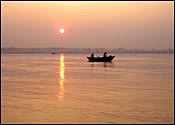|
|
|
|
|
|
|
|
|
| Varanasi Introduction |
|
 Varanasi (Banaras) is one of the oldest living cities in the world. Varanasi's prominence in Hindu mythology is virtually unrivalled. One of the earliest descriptions of Varanasi is found in the Buddhist scriptures as also in the epic, 'Mahabharat'. The 'Pali' version of Varanasi was 'Baranasi' which ultimately gave birth to the name 'Banaras'. According to the 'Vamana Purana,' the Varuna and Assi rivers originate from the body of the primordial person at the beginning of time itself. Varanasi (Banaras) is one of the oldest living cities in the world. Varanasi's prominence in Hindu mythology is virtually unrivalled. One of the earliest descriptions of Varanasi is found in the Buddhist scriptures as also in the epic, 'Mahabharat'. The 'Pali' version of Varanasi was 'Baranasi' which ultimately gave birth to the name 'Banaras'. According to the 'Vamana Purana,' the Varuna and Assi rivers originate from the body of the primordial person at the beginning of time itself.
|
|
|
Top ˆ |
|
|
| Varanasi Tourist Attractions |
|
|
| § River Front |
|
The Ghats of Varanasi truly embody the real essence of this timeless city. As the first rays of the sunset the gently flowing Ganga afire, thousands of devout take the ceremonial dip and the Ghats come alive to people from all walks of life. Each performing rituals the way they were done, centuries ago. |
|
|
| § Durga Temple |
|
Dedicated to Duga, the goddess of power, it is one of the most important temples in the city. Constructed during the 18th century in Nagara style of temple architecture, its Shikhara or spire is formed of small Shikharas, one on the top of other. |
|
|
| § Bharat Mata Temple |
|
A novel temple dedicated to Mother India, which, instead of the customary gods and goddesses, houses one of the most perfect relief maps of India carved out of marble. The nationalists Babu Shiv Prasad Gupta and Shri Durga Prasad Khatri, leading numismatists and antiquarians, gifted the temple. |
|
|
|
| § Tulsi Manas Temple |
|
Constructed in 1964 by a philanthropist family of Varanasim this temple is dedicated to Lord Ram. The temple is situated at the place where the great seer of the medieval ages, Goswami Tulsidas lived and composed the epic poem 'Ramcharitmanas' expounding the history and deeds of Lord Ram. |
|
|
|
| § Kashi Vishwanath Temple |
|
It is a gold-spiraled temple rebuilt in 1776 A.D. by Rani Ahilyabai Holkar of Indore and dedicated to Lord Shiva. The gold spire is covered with a ton of gold plating donated by Maharaja Ranjit Singh of Punjab in 1835. A.D. It is popularly known as the Golden Temple. |
|
|
|
|
|
Top ˆ |
|
|
|
|











